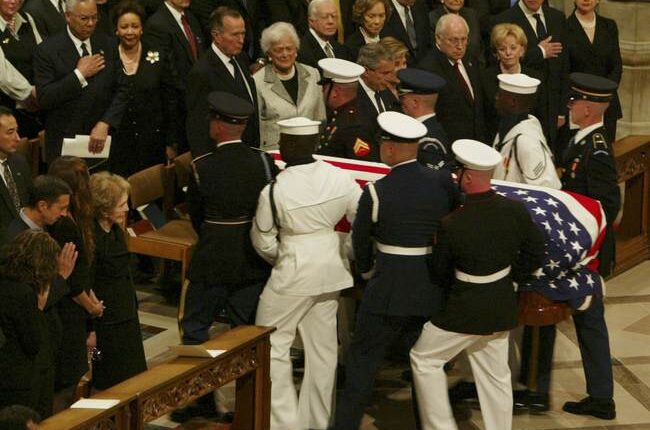
James Earl Carter, the oldest living former president of the United States, passed away at the age of 100 at his residence in Plains, Georgia. As a former governor of Georgia, his body will be honored with a lying in repose ceremony in Atlanta before being transported to Washington, D.C. There, his body will lie in state at the U.S. Rotunda for three days, culminating in a state funeral at the Washington National Cathedral on January 9, 2025.
Our most recent former president to pass away was George Herbert Walker Bush in December 2018, at 94 years of age. With the passing of these esteemed figures, it is fitting to familiarize ourselves with the customs and practices observed upon the demise of a leader who once held the prestigious title of the President of the United States.
Flags Fly at Half-Mast for 30 Days
While the terms “Half-Staff” and “Half-Mast” are often used interchangeably, the former is typically employed in official governmental settings and in relation to flags displayed on land. Conversely, “Half-Mast” is more frequently utilized in a maritime context. Considering President Carter’s background as a U.S. Naval Academy graduate and a former Navy lieutenant before entering the realm of politics after managing his family’s peanut farm, the gesture of lowering flags holds a special significance.
Per presidential declaration, all government buildings, public schools, offices, and military bases will lower their flags to half-staff for 30 days as is the custom when a U.S. president or former president dies. Carter’s date of death was Sunday, December 29, so the White House lowered its flags after President Joseph Robinette Biden’s announcement. The rest of the nation began flying their flags at half-staff on December 30, 2024, and will fly them in this manner until January 28, 2025.
The President Issues an Official Death Announcement
The sitting president is expected to issue a proclamation announcing the death of a president. President Biden made an unofficial proclamation on the social media platform X (which frankly is becoming an official source these days), before his issuance of an official proclamation for the legacy news media.
Today, America and the world lost an extraordinary leader, statesman and humanitarian. pic.twitter.com/Ki7Rhbent0
— President Biden (@POTUS) December 29, 2024
President-elect Donald John Trump issued a statement on Carter’s passing.
The President Declares a National Day of Mourning
This tradition began with President John Tyler upon the death of President in 1841 and slowly morphed into the official part of the president’s duties. According to the American Presidency Project, “The current set of rituals are fully apparent by 1969 with the death of Dwight Eisenhower[.]” President Richard Milhous Nixon issued an executive order declaring a Day of Mourning, which “closed all government departments on the day of the funeral, directed that flags be flown at half-staff for 30 days, and directed that suitable honors be rendered by units of the United States Armed Forces.” For me, that last part is the coolest.
Presidential designations of Days of Mourning are not just for presidential deaths. President Lyndon Baines Johnson declared one for the Rev. Dr. Martin Luther King Jr., and President George Walker Bush designated one for the victims of the September 11 terrorist attacks.
President Biden issued his executive order on Monday declaring January 9 as a National Day of Mourning on the death of former President Carter.

















